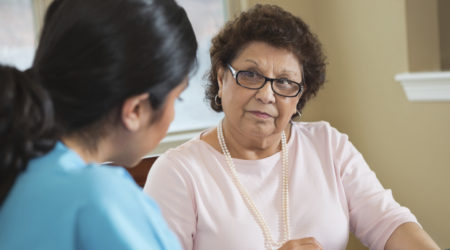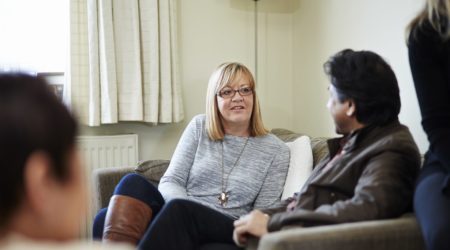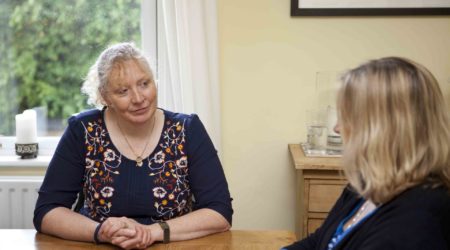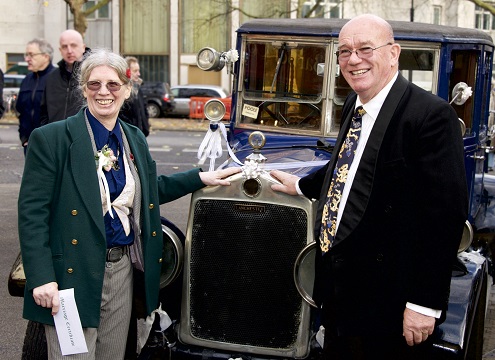

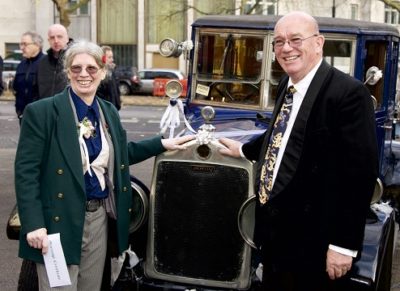

Maggie
Maggie, 70, was diagnosed with inoperable pancreatic cancer in September 2016.
I had a health check in June 2015 and all was good apart from high calcium. I then went along to my GP because I was getting a lot of heart burn. I was sent for a stomach endoscopy on the 26th June which was clear. I was told by my GP not to eat so much spicy food so did nothing more.
A shock diagnosis
In May 2016 I went to the GP for something totally different (I was bloated and thought I had a prolapse). She checked me and sent me off for an ultrasound to check my uterus. I was then sent off to have another test about a week later at a different hospital and gained a gynaecology consultant. I had a CT scan to check my ovaries and abdomen more closely. This showed an abnormality on the pancreas and lesions on the liver.
On 5th September I was passed onto the gastrointestinal surgical unit, where I first met my specialist nurse. I had an MRI scan on 9th September which showed I had a 3-3.5cm lump on my pancreas which was blocking the bile duct.
On 20th September, my specialist nurse told me they thought the it was a neuroendocrine tumour (NET) since I had no symptoms, no weight loss, and was so fit. If I had pancreatic cancer I would not be so fit and healthy. I was given 25,000 units of Creon (3 doses with meals) because of floating stools, to replace the enzyme to help me digest fat in my diet for the rest of my life. This would avoid weight loss. I was also prescribed 20mg Omeprazole capsules.
A biopsy on 4th October was performed to check if it was a NET or pancreatic cancer. It was the latter. They were able to take 2 samples of the pancreas as I had a small stomach – normally they would take samples from the liver since it is more accessible.
On 11th October I was told by the specialist nurse I only had months to live. I could not have surgery as the cancer had spread to the liver and it was a difficult operation anyway. I would have GemCap (Gemcitabine and Capecitabine) chemotherapy and would get more and more tired and weak rather than pain and side effects. Massive shock.
Treatment Choices
I was asked if I had any targets to set, and I said I had to write the definitive book about Clifton Rocks Railway to leave as a legacy, to continue taking groups down the Railway (which had 320 steps to go up and down), keep driving my vintage cars and live life normally as long as possible. My two sons came to see me that weekend to discuss financial affairs and then came down the Railway tunnel with me to discuss the book and how long each chapter should be. They were incredibly supportive. We then asked a probate solicitor for advice, who advised my partner and I to get married.
On 17th October I was put under oncology at a different hospital and saw the consultant. Even though I was at a different hospital I would still work with the same specialist nurse. I was assured the cancer was not genetic. I was then given choice of GemCap or Folfirinox. I did not expect a choice! It was difficult to choose as I expected the doctor to tell me what was appropriate for me. I rang my specialist nurse for advice and she reassured me that if Folfirinox was too hard on me the dose would be reduced or I could switch to GemCap anyway.
Writing my book and getting married
On 18th October I started writing my book on Clifton Rocks Railway, using research gathered over 12 years of working there. On 4th November I got engaged to my long-time partner.
I started treatment on 30th November and we got married on 6th December. This date was chosen so that my wedding could go ahead with me suffering from the least side effects. The wedding went very well and was very cheerful considering how it could have been. We had 70 guests. We originally thought of having a small wedding with 3 guests as we did not know in what state of health I would be, but thought everyone would be upset if they were not invited.
My fiancé organised a hen night for me, and I was given a book with peoples’ funniest memories of me in it. This was comforting as it showed how much people cared for me. We had an unconventional wedding with very little planning involved. My oldest son gave me away, and my other son was my best man. We had a poem about vintage cars in the ceremony, and then a friend of mine drove us to the reception in my vintage car. We then did trips down Clifton Rocks Railway for the guests.
In January my GP asked me where I wanted to die – which upset me as I felt so well. She said she had to ask while I was well as my health would deteriorate quickly.
Finishing my treatment
I was declared stable in February 2017, and again in June 2017 from CT scans. Treatment finished 11th May. I was to have blood tests every 3 months but asked for them more often in October for confidence (being asymptomatic I did not understand how they could check progression in an aggressive cancer quickly when only tested every 3 months. I was mindful of the panic in 2016). Now my blood tests are every 6 weeks.
My CA19-9 levels varied and I drew a graph to help me visualise it better. In August 2017 my consultant said relapse signs would mostly be systemic – reduced appetite, weight loss, fatigue or nausea, possibly a recurrence in heartburn and so I should only worry about CA19-9 if it went into the 1000’s.
Side effects and symptoms
I still have few symptoms. I am rarely tired, have not lost any weight and I am still pretty fit. I have lost my dizziness when getting up from lying down, did not lose all my hair, though it went very wispy (people think I look better with shorter hair), my stools still float but are well-formed thanks to Creon.
Everyone has always said how well I look, but they say that even more now, and I am walking quickly again now my feet improving. So I have just got on with my life, finished my book, I am still on the committees of various heritage societies having found it pretty hard to find other people to hand over my tasks to, so I am very busy.
I think the thing that struck me the most about my symptoms was the unpredictability. I have a maths degree so I have a logical mind. I had hoped to see values follow a path and rules for age, gender etc. but apparently everyone behaves differently. This is why I ended up drawing graphs for myself to see if I could see a pattern for me!
I was told I had good blood which helped, a positive attitude, and was fit which had all contributed. I felt I was too young to die and had too much to do with my life which I enjoyed.
Staying focused
During my treatment I continued to stay active and immersed in writing my book, ‘The ups and downs of Clifton Rocks Railway and the Clifton Spa. The definitive history’. Writing my book has helped me stay focused on something and I could proof read sections when sitting in hospital. I even did a radio programme about the railway when I had my chemotherapy bottle on me, and for BBC Bristol Blitzed I had to splash in some puddles to help the sound effects – I didn’t like to tell them that it was not really sensible with my neuropathy!
Between October 2016 and June 2017, I did helped guide over 300 visitors each day in the Railway (I am the Restoration Officer) sometimes with chemo bottle round my neck. I also did 7 work sessions down at the Brunel swivel bridge and guided a group of 40 school children round the area. We also attended a Lanchester Rally in June where I drove my 1924, 2 ton limousine round Dorset with no problem (which has no power steering). I couldn’t book the hotel room until late on as I did not know whether I would be alive.
The book I was writing was largely completed by August and I had my team and sons to read chapters to test for readability and comments. This helped them too as they knew they were doing something constructive to help me. There was much proof reading in October 2017, so it took 1 year to write – 317 pages long, 430 images. The book was delivered in December and has had rave reviews and is selling well.
Diabetes
In March 2018, I was diagnosed with generalised diabetes (due to my illness). I had noticed I was always thirsty in January but thought nothing more since I was not overweight, never smoked and hardly drank. I had been asked to speak at the Pancreatic Cancer UK Annual Summit and one of the nurses there suggested I could have diabetes. That evening, due to very heavy snowstorms, when we arrived back in Bristol on the train there was no transport, so we had to walk 3 miles back home in a blizzard, much up hill. I was pleased to have been able to do it, but the next day I was exhausted and slept all day! In retrospect, maybe I should not have even tried but I had no alternative.
After lots of blood tests, it was finally decided I should start on Metformin tablets which would release insulin steadily all day and night (this was after the GP had a panic after very high blood glucose and HBA1C and debated if I should get an emergency insulin dose in hospital). I asked why blood glucose levels had not been checked throughout my treatment, since the pancreas is responsible for making insulin. The GP thought it was a good idea.
I am now trying to figure out my erratic blood glucose levels since I have been given a meter so that dosage can be monitored! Nothing is easy, but at least my pancreas is still producing insulin – just not enough. So, I am now losing weight slowly. I am trying to see a dietician but they are very scarce. My next visit in a few weeks time to my consultant should be interesting.
April 2018
Update September 2018
Just before Christmas 2017, it was noted that my ALP level and my CA19-9 (a tumour marker detected in blood tests) were going up. Because it was Christmas it was decided by the GP to do nothing. My blood was being monitored every 6 weeks.
I saw the consultant in January and asked for a CT scan, which I had in March. I was advised if one had too many scans one would worry about getting the results, but looking at my blood results I thought I was justified to have one. I then started to lose weight (1 stone), and my blood results got worse. The scan showed that although the pancreatic tumour was still stable, the liver tumours were getting bigger and some had appeared on the lymph nodes.
Managing my diabetes
In the mean time I went on an introductory course to diabetes which was organised by my GP. The trouble was that everyone wanted to lose weight and I wanted to gain weight. I managed to self-refer myself to a dietician who was very helpful. She advised me to forget about the low glucose diet so I could gain some weight as that was more important, and to have a higher fat diet (the result of which made my husband’s weight go up but mine stayed low). My diabetes was improving.
I also had to have my eyes checked because of the diabetes. This all meant lots more appointments since I had so many people looking after my welfare – dietician, diabetic nurse, blood tests, consultant, acupuncture for neuropathy, so I gave up the chiropractor. The nurses at Pancreatic Cancer UK were also very helpful in discussing tactics and encouraging me (and trying to get me to rest).
Chemotherapy and its side effects
I then started chemotherapy on 30th April. This time I was on GemCap (Gemcitabine and Capecitabine) for 6 months and had to get more involved in the treatment due to sickness and problems with glucose levels. Last time I had just got on with my book and just dealt with the side effects as they happened and let the consultant make the decisions.
Because the GP had panicked when they first saw my glucose levels and wondered if I should be rushed into hospital to get an emergency dose of insulin, I had realised diabetes was serious enough to worry about it. I didn’t want to be sick as I had to swallow lots of capecitabine tablets and didn’t want to lose them. The consultant suggested that I should have steroids to conquer the sickness, but then they sent my glucose sky high. At least I realised that one could get up to 25 without ill-effects!
I could be sick at any time with no notice, so ondansetron was no use as you could only take that for 2 days. In the end we decided to have steroids every week when I had my drip, to check my glucose levels the day before, during the day and the day after the trip, and to take insulin in the morning before the drip to level the glucose and take it the following day if I considered my glucose was still too high. I was also advised to drink a lot of water if my glucose went too high. I could tell my levels were getting high when I got a hot head and was thirsty. I took metoclopramide three times a day and this resolved the problem. However, I then had to contact the DVLA and my car insurers because I was taking insulin – this was fine because I was driven too and from the hospital when I had had insulin – what a relief!
A blood clot in my leg
At the end of June I went on my annual vintage car rally for four days to prove I could still drive my 2-ton car with no power steering. I managed the rally fine and even put some weight on, but on the morning I was due to go home I had a pain in the back of my leg. At first I though I had strained a muscle because of the heavy pedals but the pain got worse. We ended up ringing oncology at 5am (it had been agreed it was better to ring them than A+E) and they gave me a clexane injection in case I had a blood clot. Of course being a weekend it was not possible to get ultrasound, so on the Monday it was shown that I had a blood clot in the back of my leg. My leg was absolute agony for several days so I had to watch a lot of the World Cup. I could not even get downstairs to use my computer. The clexane resolved this problem but I hate injecting it as it has such a big fat, long needle.
Good news and a birthday celebration
My CA19-9 started to go down, as did my ALP. I had to miss several treatments due to my platelets or my neutrophils being too low. My weight started to go up by 1lb a month. I then had a CT scan at the end of July to check progress, and found that the lymph tumours had gone, the liver tumours were barely visible, and even the pancreatic tumour had shrunk. This was unbelievable news.
I have kept busy doing many things to do with heritage and the societies I work for, and on open doors day at Clifton Rocks Railway helped to show round 1700 people over the weekend with hardly any food.
I am about to celebrate my birthday and the fact that I am still alive. My husband has organised a party with 70 guests. They will have to spread around the garage as well as the house! I have to go to chemo first and managed to get the time moved as I did not want to be late for my own party!
So it has been a roller coaster couple of years. Would I have done better on GemCap the first time? Who knows? I have had virtually had all the side effects of both treatments. My hair has grown back – unbelievably I am still blonde – I thought I would be white. Sometimes the hair is curly, sometimes straight, sometimes darker, sometimes paler. People think I have had highlights but I am not that kind of person.
What will the CT scan show after my treatment finishes in November? I was told that if the cancer is being aggressive then it can respond better to treatment.


